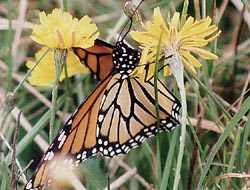

The article below was substantially revised in February 2000 with the latest information on this issue since it first appeared in the March 1998 "Monarch News," a monthly publication of The Monarch Program/Western Monarch Studies. The article addresses a statement printed by the North American Butterfly Association in Spring 1998, which has been widely quoted in the media.
On 13 June 2001, The Washington Times newspaper seriously misquoted the position of the Butterfly Conservancy on the butterfly release controversy. I wrote the Editor and requested he publish an errata. No response was ever received. To read my correspondence with a link to the article, click >> here <<.
by Sheri Moreau
1. Commercial butterfly breeders are NOT releasing “tens of thousands of Monarchs” on the “wrong side” of the Continental Divide (i.e., outside of their natural migration pattern), therefore “mixed-up monarchs” are not a problem—even if physiologically, the phenomena could occur at all, which has been repeatedly disproved. There are strict State and Federal permitting requirements for the transportation of “plant pests” (which includes all members of the order Lepidoptera: butterflies and moths) across state lines. Most butterfly breeders today are in full compliance with regulations against trans-continental butterfly movement. Concerned butterfly clients can easily verify that their vendor has valid permits by visiting the USDA APHIS Plant Protection and Quarantine website.
2. In point of fact, there have been nearly two decades of eastern/western Monarch transference research, with multiple reports of successful migration by relocated butterflies to the geographically appropriate overwintering area for the “adopted population” such as the Monarch caught in Marin County, released in Nebraska during the fall migration, and recovered in Mexico. There have also been cases of eastern Monarchs released in the Sierra that were recovered at overwintering sites along the California coast. Observation and tag-and-release studies conclusively prove that in the vicinity of the Continental Divide, putative “eastern” origin Monarchs will migrate to California, and “westerns” will migrate to Mexico. “Mixed-up” these Monarchs may be by human geographical border definitions, yet the butterflies still find their way to where they can safely survive winter’s cold. The determining factors appear more likely to be wind, weather, magnetic orientation and geography, not natal origin. In putting out their statement, the NABA co-signers deliberately ignored this research data.
3. In the past 20 years, there have been three separate DNA studies (four, if you count the University of Minnesota study currently in press) that have failed to discern significant differences in DNA between eastern and western Monarch populations. Natural population transfers occur during every windstorm. English lepidopterists reported at least 20 North American Monarchs found alive in the British Isles in the fall of 1998. Why is this information being ignored, even squelched?
4. In trying to put some rational numbers on this whole issue, Dr. Chip Taylor, director of the University of Kansas’s Monarch Watch, estimated that less than 30,000 artificially raised Monarchs were released in the United States in 1997, an estimate which combined commercial and educational releases together. With an estimated eastern/western Monarch population of 355 million, that equates to some 1.96e-12 percent, hardly a statistical blip in the total population. To help put these numbers in perspective, University of Minnesota Monarch researcher Dr. Karen Oberhauser notes in her instructor’s guidebook, “Monarchs in the Classroom” that each season birds and mice together consume over 3 million Monarchs per 2.5 hectare overwintering site in Mexico, or more than 24,000 per day per site. Currently, there are 11 such sites known.
5. In view of years of research to the contrary, it is difficult to conceive of a case wherein a Monarch’s “delicate migratory physiology may not have been turned on.” Robert Gendron, a Cal-Poly student with over six years of experience in Monarch tagging research, reported that in the 1997-1998 overwintering season, fifth generation captive-bred Monarchs released in the San Francisco Bay Area were subsequently spotted in four overwintering sites from Santa Cruz to Pacific Grove. In the 1999-2000 season, to date 17 7th generation Monarchs released in the Sierra have been observed at overwintering sites along the California coast. Dozens of tagged eastern Monarchs, hand-reared in classrooms by school children, have been released across Canada and North America and been recovered at Mexican overwintering sites. While some of these Monarchs were raised from wild-caught larvae, many thousands of them were from larvae sold in educational kits by the University of Kansas. Certainly the migratory mechanism was fully functional in these butterflies, reared hundreds, even thousands of miles from their birthplace.
6. Stating that overwintering sites in Mexico are now targets for butterfly release poachers is, frankly, ridiculous. Very few places in the USA are suitable for Monarch releases while the hundreds of millions are resting in Mexico, resulting in virtually no market for butterfly releases from mid-October to mid-April, a timeframe which exactly opposes the months the clusters are available for poaching. Then there is the difficulty of smuggling them into this country alive, once a would-be poacher has somehow located a market. It would be remarkable if poaching for release events is really occurring; certainly there has been no evidence or reports of such activities. Nor have there been reports of net-wielding bridegrooms sneaking into California Monarch sanctuaries during the overwintering months. The market—and the weather—simply aren’t conducive to live butterfly releases in the winter.
7. Stating that “butterflies raised by unregulated commercial interests may spread diseases and parasites to wild populations, with devastating results” is in direct contravention to what butterfly breeders experience in their farming operations. Commercial breeders who do not maintain pathogen-free breeding conditions are out of business in a season or less. Predators, parasites and pathogens have far more impact on wild butterfly populations, where less than 2% of all eggs are able to mature into adult butterflies. Simple observation can quickly demonstrate this: wild butterfly larvae brought home and quarantined for observation are often (20%-85%) infested with tachinid fly, ichneumon wasp, or brachonid wasp larvae; problems which rarely, if ever occur in captive-reared populations. Wild Monarch adults tested around the USA have 5% - 95% infestation rates. Dr. Kingston Leong of Cal-Poly has published research data reporting this protozoa in every state in the USA (less Alaska) and in every other population of Monarchs world-wide. A decade of field research has shown that the habits of wild Monarchs are adapted to this protozoa, and result in successful co-existence, otherwise we would certainly not have had the record numbers of Monarchs observed in 1997-1998. Interestingly, Dr. Sonia Altizer, while a University of Minnesota graduate student doing her dissertation on Monarchs, reported at the November 1997 tri-country Monarch conference that the offspring of eastern Monarchs crossed with western Monarchs were MORE resistant to the Ophryocystis elektroscirrha protozoa, the disease of most concern to the NABA statement co-signors. Her final results are currently in press and are expected out in early 2000.
8. It is important to remember that all butterflies are pollinators for plants and food for other creatures, whether in their wanderings they enter areas where their specific host plants exist or not. Butterflies have wings; state boundaries are invisible to them. Any major storm system sweeping across the country relocates and/or kills tens of thousands of butterflies. A female butterfly unable to locate her host plant will move on, just as they do all summer long. Yes, there are butterfly species that cannot successfully adapt to ecological changes, many if not most of them small, fragile-winged, and area-specific species (the blues seem particularly environmentally fragile). By comparison, Monarch host plants are found nearly everywhere in North America, and strong fliers that they are, Monarchs are one of the most widely dispersed butterflies in the world.
9. A thoughtful reader must seriously question the allegorical comparison and recommendation in the NABA statement between the “1947 outlawing of the intentional release of native birds” and putting a stop to the release of butterflies. Insects are not in the same classification as birds; the two Phyla don’t even begin to be comparable. In point of fact, hundreds of thousands of bobwhites, quail, pheasants and turkeys are released in this country annually. When making dubious allegories, did the authors consider halting the release of millions of salmon fry each year—after all, these are migratory fish. Moreover, tens of billions of predatory and sterile insects are released each year as natural biological insect controls-putting a stop to that would mean megatonnage increases in pesticide usage, scarcely a desirable outcome.
![]() There
is indeed an unprecedented and heartwarming interest in butterflies now
occurring in the United States. The recent trend of butterfly releases,
while statistically of negligible impact on overall butterfly populations,
has resulted in significant favorable media attention, and is directly
responsible for increased public awareness of, and regard for, butterflies.
Butterfly exhibits are proliferating around the world. It is time for
the doomsayers to do the math on this whole issue, and to recognize that
regulated, conscientious commercial butterfly breeders serve important
roles in public butterfly exposure and education, and in reality, significantly
contribute to habitat restoration, pesticide-usage reduction, and the
overall well-being of butterflies worldwide.
There
is indeed an unprecedented and heartwarming interest in butterflies now
occurring in the United States. The recent trend of butterfly releases,
while statistically of negligible impact on overall butterfly populations,
has resulted in significant favorable media attention, and is directly
responsible for increased public awareness of, and regard for, butterflies.
Butterfly exhibits are proliferating around the world. It is time for
the doomsayers to do the math on this whole issue, and to recognize that
regulated, conscientious commercial butterfly breeders serve important
roles in public butterfly exposure and education, and in reality, significantly
contribute to habitat restoration, pesticide-usage reduction, and the
overall well-being of butterflies worldwide.
![]()
About the Author: Trained as a wildlife biologist at Texas A&M University, Sheri Moreau is a past member of the Board of Directors of both the Monarch Program and the International Butterfly Breeders’ Association, and Director of The Butterfly Conservancy. She has raised Lepidoptera for the past 36 years.